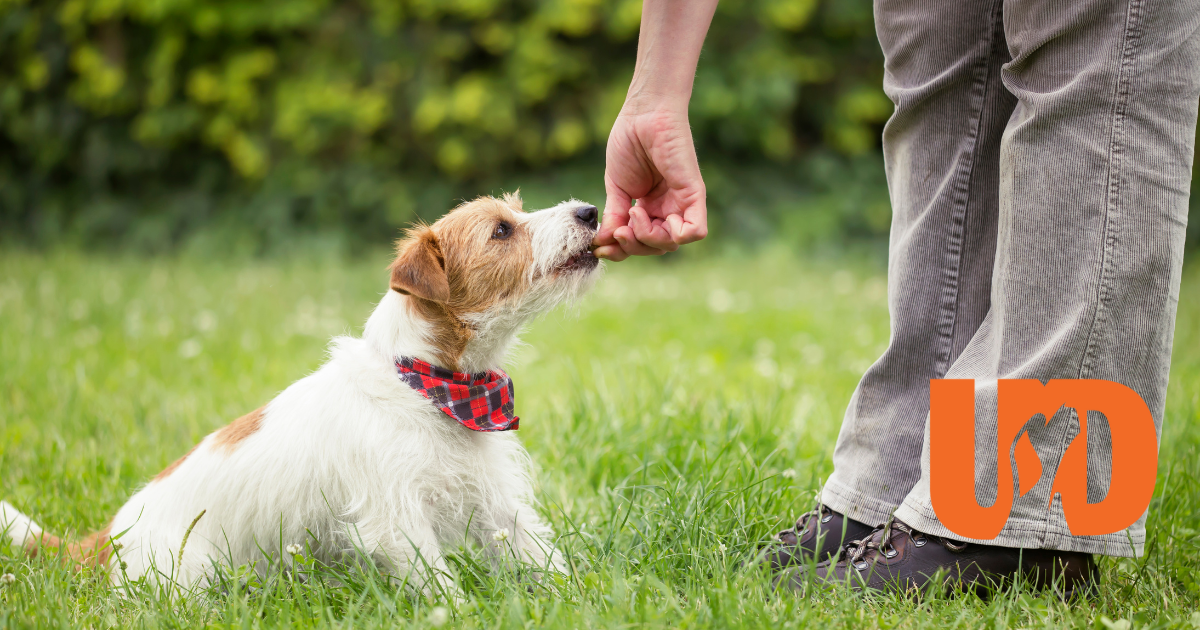The Power of Positive Reinforcement — And Its Hidden Pitfalls Positive reinforcement is one of…
Bonding with Dogs: The Art of Building a Strong Relationship
A strong relationship with your dog is crucial for their well-being and effective training. Building a relationship founded on mutual respect, trust, and consistency paves the way for a healthier, happier dog and a more productive training process. The knowledgeable and caring professionals at University of Dog are here to help you do just that.
In this blog post, we’ll identify practical ways to bond with your dog, look at the nuances of how to bond with your puppy, and explore the role of training in fostering this bond.
Patricia McConnell’s book “How to Be the Leader of the Pack” is an excellent resource for insight into relationship building. Our university’s founder Tecla Walton also has a comprehensive video on the topic:
These resources emphasize an important belief we have at University of Dog – training needs to be a lifestyle; it can’t be isolated sessions. You need to incorporate training and relationship-building into your everyday life.
Bonding with Your Dog: Practical Ways to Cultivate a Strong Relationship
Many practical ways to bond with your dog involve fair leadership, building respect, and positioning yourself as a source of positivity in your dog’s life. Here are some tips:
1. Leverage Things Your Dog Enjoys Like Affection and Play
Tecla has 2 easy rules to help guide you through this: 1. Your puppy or dog should not initiate affection or play interactions. 2. Your puppy or dog should do something to earn affection or play from you.
This tip may seem counterintuitive, but it relates to clarity in leadership. In leader/follower relationships, the leader generally initiates interactions.
Allowing dogs to initiate affection or play by demanding it (e.g. pawing, nudging, dropping a toy insistently) can reinforce pushy behavior, leading to problems in other situations.
By having your dog do something like sit first before giving affection or play, they have “earned” the reward, setting up a structure for your dog. Of course we are not suggesting that you cannot share affection or play with your dog. What we care recommending is to set up conditions that these desirable outcomes happen on your terms; it’s not a demand from your dog.
You control the resources of affection and play. The goal is to reinforce that good things come from you on your terms, supporting the bond and leadership role.
2. Practice Using Personal Space Appropriately
As humans, we’re taught to be polite and yield space. However, automatically yielding space to dogs can send the message that they are the ones in control or that they do not need to have a healthy respect for your personal space.
If your dog is blocking your path, don’t go around them. In dog language and hierarchies, personal space is seen as a resource and interactions around it affect relationship significantly.
Walking confidently through your dog shows you expect them to respect your space and defer to you. It establishes you as the leader who controls resources like space, but you aren’t using force, just a clear physical presence. But remember, do leave sleeping dogs lie – if your dog is sleeping, never walk through them!
Being consistent about expectations around personal space prevents confusion and helps dogs know what to do when you approach. It relates to real-life situations – if your dog expects you to go around them, they are less likely to respond when you need them to move and if they respect your personal space you will greatly reduce the likelihood that they will jump on you when they greet you.
Respectfully but confidently occupying your space reinforces your leadership role and the dog’s respect for you in a non-confrontational way. It clarifies that you control space and movement, not the dog.
3. Practice Door Manners
Doors and gates often lead to exciting or rewarding places like the yard. Rather than letting dogs explosively burst through doors and gates, this technique creates structure.
It reinforces that your dog should look to you for permission before entering fun areas. You control the access.
With this technique, your dog is waiting for a cue from you, as the leader, for what to do next – either proceed through the door, wait for you to go first, or be called through. By sitting and making eye contact in this situation, your dog demonstrates impulse control, respect, and engagement with you.
Practicing this method consistently strengthens the bond through rules, impulse control, and focused engagement between you and your dog.
4. Be Consistent
Dogs thrive with consistency and predictability in rules and responses. It makes their world understandable.
When you are inconsistent – allowing a behavior sometimes but not others – it confuses your dog. This bad habit can lead them to ignore your commands when you really need them to comply.
Consistency builds trust and reliability, letting your dog know what to expect from you. For example, if you don’t want your dog on the couch, never allow it, not even once.
Being consistent demonstrates fairness and helps you earn respect in your leadership role. Sticking to clear and consistent rules day-to-day makes you predictable and reliable in your dog’s eyes, fostering trust, understanding, and care for your leadership.
How to Bond with Your Puppy: Setting the Tone Early
The first year of a puppy’s life represents a critical window for bonding and shaping behavior. Puppies look to their owners to understand how to act. It’s important to address unwanted habits like jumping up or demanding affection, as allowing these behaviors early on can reinforce pushy behavior. Remember, what’s cute in a puppy can become unmanageable once your dog is fully grown.
When it comes to how to bond with your puppy, it’s crucial to set the right expectations from the beginning. If we encourage certain behaviors in puppyhood, we should be prepared for them to persist into adulthood. Being consistent and fair in your expectations helps establish a clear communication line between you and your puppy.
The following additional tips will help you bond with your puppy:
1. Hand-Feeding
Hand-feeding your puppy scheduled meals builds value and engagement. As the sole food provider, you establish yourself as a high-value resource. Make training sessions and simple commands part of your puppy’s mealtime routine. This exercise strengthens the bond through positive reinforcement.
2. Avoid Harsh Corrections
Many common puppy behaviors like nipping, jumping or chewing can oftentimes be easily redirected with appropriate use of food, toys, use of recognition markers like “yes!” to praise good choices and where necessary mild redirective corrections/communication. Harsh corrections can damage trust; instead, set your curious puppy up for success.
3. Stay Predictable
Since puppies thrive on predictability, be consistent with rules and responses. Allowing a behavior one day but not the next is confusing. Stick to routines and say cues the same way each time. Your consistency will reinforce the partnership.
While bonding with your puppy takes work, the payoff is an attentive companion who respects and wants to please you. You’ll lay a strong foundation for years of friendship by focusing on clear communication, consistency and compassion.
Lead Because You Love
The driving force in bonding with dogs should always be love. Leadership is about serving your dog’s best interest, keeping them safe, and maintaining consistent, transparent, and fair communication. Leading with love means relating to your dog through compassion, not force.
A caring leader gets results through devotion, not dominance.
While boundaries and rules are essential, they should come from a place of caring, not domination. Reward desired behaviors as much as possible and where necessary apply with a minimal amount of redirective correction/communication to change behavior to something you can reward. Remember positive energy, affection and praise are powerful reinforcers.
When you see the world from your dog’s perspective, you’ll be more patient with behaviors that come naturally to them. Guide them with empathy to make good choices, and remember, understanding breeds patience.
Lead by example and model calm, consistent energy
Compassion takes effort but pays dividends in the form of a deeper bond, helping your dog look to you as their secure base. While training requires effort, your dog’s loyalty comes from a place of him seeing you are fair and consistent, and when you nurture that, your bond will continue to grow.
Build a Stronger Bond with Your Dog at University of Dog
In a world where bonding with dogs is often overlooked, you can make a difference in your pet’s life by understanding and implementing these methods. At University of Dog, our approach to forming a stronger bond is grounded in compassion, respect, and a profound understanding of dogs.
Whether you’re a new dog owner looking to build a better relationship with your puppy or an experienced dog owner hoping to improve your bond, we can provide you with the knowledge, tools, and techniques to achieve your goals.
Take a course today, and let’s work together to create a deeper bond with our dogs – one that enriches our lives in incredible ways. After all, our best friends deserve the very best from us. Let’s give them just that.



